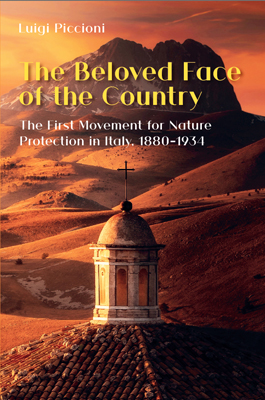The Beloved Face of the Country
The First Movement for Nature Protection in Italy, 1880–1934

Luigi Piccioni (translated by James Sievert)
Between 1880 and the outbreak of World War One, a large movement for landscape and nature protection flourished in Europe, driven primarily by a nationalist culture, but also featuring a strong international outlook. In contrast to the post-World War Two period, the lines in the movement’s objectives between wilderness, landscape and cultural and artistic heritage were very blurred, and scientific and humanistic knowledge both played an equally important role. In Italy, a network of associations and institutions was built up and then eventually faded between 1885 and the beginning of the 1930s. Although this network did not succeed in deeply influencing the scientific and civic culture of the country, it achieved important successes and placed Italy at the forefront of Europe in terms of environmental and landscape protection. Among the most significant results of this mobilisation was the law of 1923 for the defence of natural beauty, which later formed the basis of Article 9 of the Constitution of 1948, and the creation of the national parks of Gran Paradiso and Abruzzo, among the first to be established in Europe. This book analytically reconstructs the events of the nature protection movement, contextualising them in the cultural and political-institutional climate of the time; highlights the movement’s full inclusion in contemporary European protectionist initiatives; and attempts to take stock of its significance and historical legacy.
Piccioni retrace finement les mutations … entre naturalisme et identité nationale.
Rémi Luglia – Histoire et Sociétés Rurales
‘As the climate crisis presses, we need astute historical analyses, like Piccioni’s, of both the successes and failures of environmental movements.’
Elena Past – Journal of Modern Italian Studies
‘… a sensitive and precise translation of Piccioni’s book, which single-handedly, is destined to give Italy a venerable place in the history of global conservation.’
Marcus Hall – Global Environment
‘Dies macht seine Darstellung des italienischen Falls nicht nur für vergleichende nationale Studien wertvoll, sondern auch anschlussfähig für eine noch zu schreibende Geschichte des europäischen Naturschutzes’
Patrick Kupper – H/SOZ/CULT
‘The book makes for a great read and provides a detailed overview of the history of the Italian nature conservation movement around 1900.’
KRISTIAN MENNEN – European Review of History
‘represents a remarkable and timely scholarly contribution to the historiography of environmentalism’
LAURA DI BIANCO – H-Net
THE AUTHOR
Luigi Piccioni (Ph.D. in Humanities) is an economic and environmental historian and a professor at the University of Calabria. His initial research over a long period of time was the economic history of Southern Italy in the modern age. But he has increasingly dedicated himself to environmental history, making it his main field of research.
The topics on which he has focused his attention are the history of Italian environmentalism, in particular the pioneering activities that took place in the late nineteenth and early twentieth centuries; and environmentalism from the Second World War to the present, including national parks and protected areas, as well as the relationship between environmental issues and the cultural, political and spiritual currents of the 1960s and 1970s. His publications in English include the book Forty Years Later: The Reception of the Limits to Growth in Italy, 1971–1974 (2012), and he was editor of the book Ninety Years of Abruzzo National Park 1922–2012. Proceedings of the Conference Held in Pescasseroli, May 18–20, 2012 (2013). He has also written several articles in English, including ‘The rise of European environmentalism: a cosmopolitan wave, 1865–1914’, ‘Only one Earth: The Holy See and ecology’, ‘Protectionism and the protection of nature in Italy over the end of nineteenth and the first half of the twentieth centuries’, and ‘Protecting the Alps. Italian protected areas in the Alpine Range 1911–1991’.
He is vice-president of the Italian Society for the History of Fauna and director of the environmental history magazine altronovecento.
THE TRANSLATOR
James Sievert received his Ph.D. in environmental history from the University of California, Santa Cruz. He is the author of the book The Origins of Nature Conservation in Italy.
CONTENTS
Acknowledgements
Biographical Note
List of Abbreviations
Introduction
PART I: THE PREMISES
1. Momentum from the nineteenth century goes uncaptured
2. Flora and fauna under threat: natural scientists take to the field
3. Travel and ‘getting close to nature’: tourists and outdoor activities
4. Protecting the heritage: the walls and the arches
5. The political representation of the movement: a civil interpretation of modernity
PART II. DYNAMICS AND EVENTS
6. Fin de siècle: the first crises and the first responses
7. The turning point 1904–06
8. Across borders
9. From 1907 to 1914, a season of projects and hopes
10. The great caesura
11. Achievements
12. A long agony with a glimmer of light
PART III. REVIEW
Some reflections
Italy’s first protectionism illustrated
Illustrations
Bibliography
Index
Publication date, 1 December 2020
ISBN 978-1-912186-15-0 (PB) £30. 330 pp.
